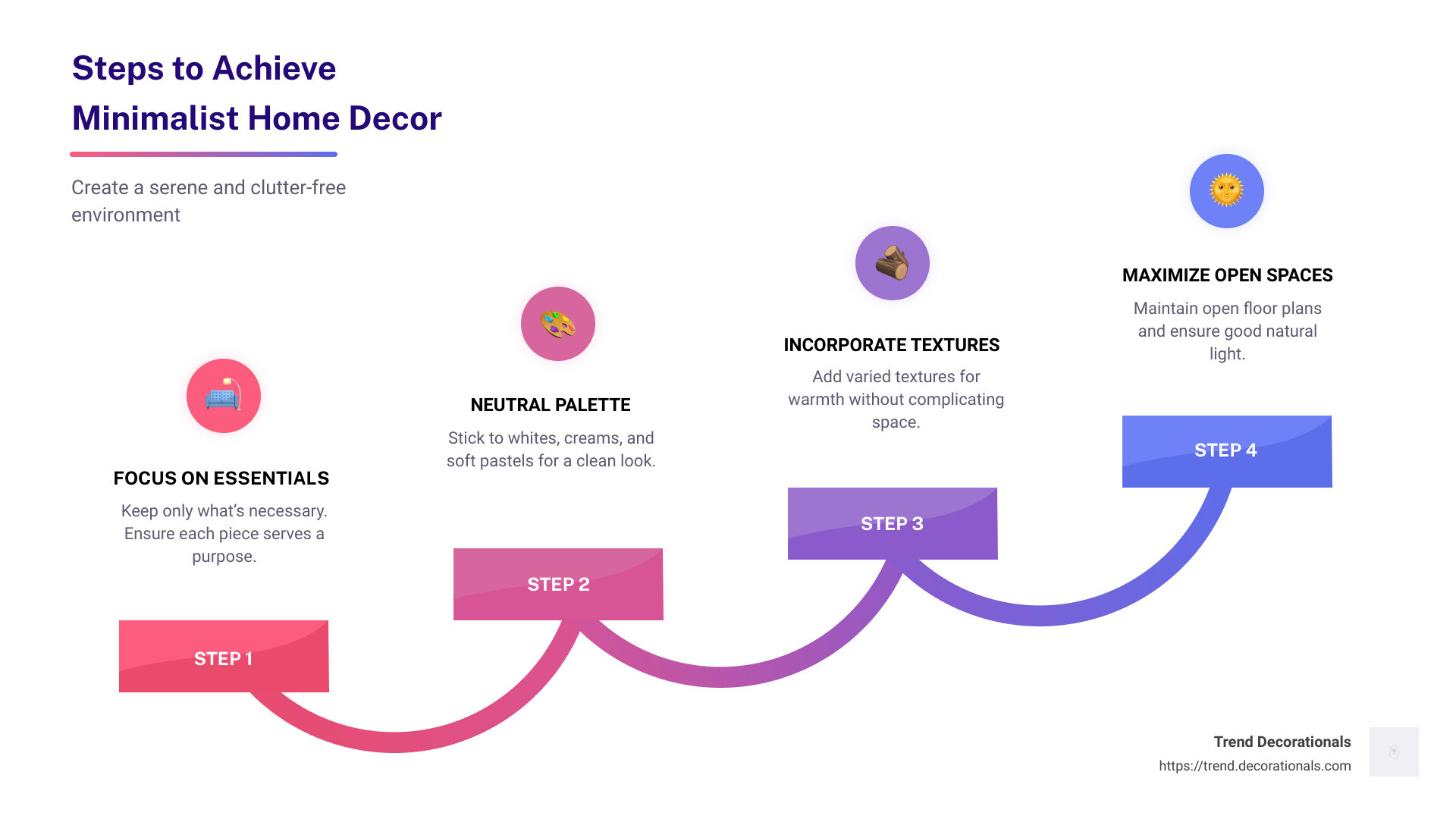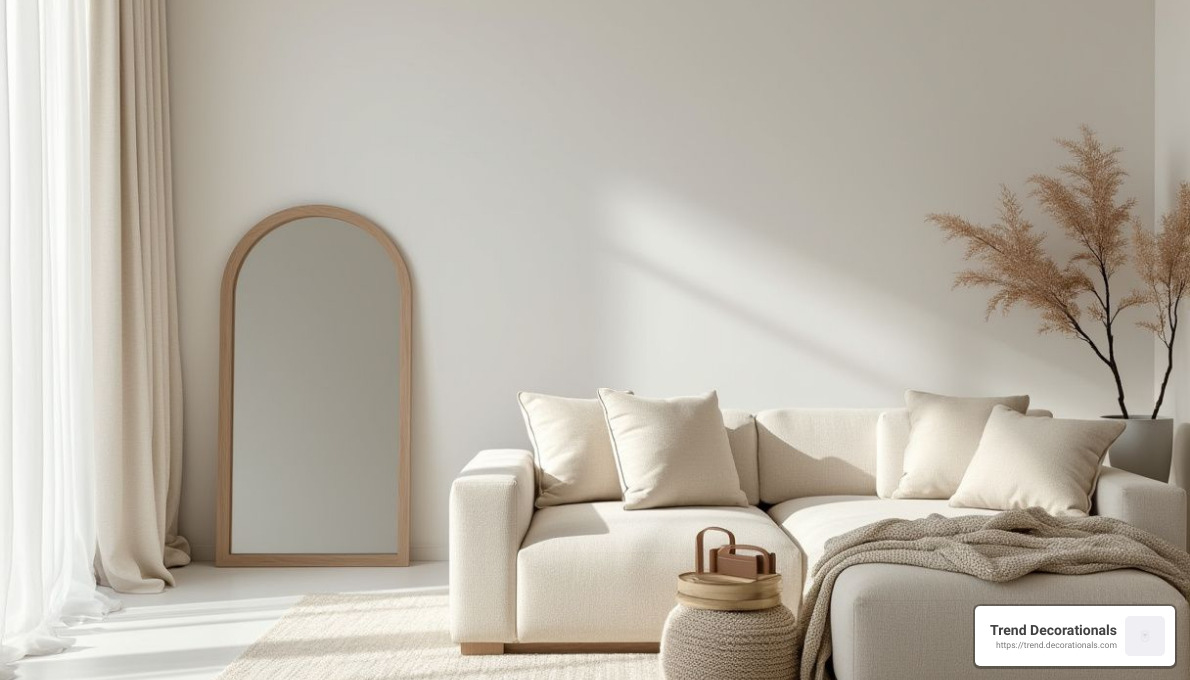Minimalist Home Decor: 5 Essential Ideas to Love in 2024
Finding Minimalist Home Decor
Minimalist home decor is all about embracing simplicity and functionality while creating a serene and clutter-free environment. If you’re looking to transform your living space with this popular design aesthetic, here are some quick pointers to get started:
- Focus on Essentials: Keep only what’s necessary and make sure each piece serves a purpose.
- Neutral Palette: Stick to whites, creams, and soft pastels for a clean, calm look.
- Use Textures: Incorporate varied textures to add warmth without complicating the space.
- Open Spaces: Maximize every square foot by maintaining open floor plans and ensuring good natural light.
In interior design, minimalism has become synonymous with peace and order, and it goes beyond just aesthetics—it’s a lifestyle choice that prioritizes quality over quantity. Inspired by the calming effect of simplicity, this style encourages us to reduce clutter, both physically and mentally. As Becky Shea, a renowned designer, beautifully puts it, “Minimalism isn’t just about having less; it’s about cherishing what you have.”
Designing a minimalist home does require intention and discipline. It’s about curating your environment to reflect tranquility and purpose.

What is Minimalist Home Decor?
Minimalist home decor revolves around the “less-is-more” philosophy. This approach is about reducing clutter and focusing on the essentials to create a peaceful and functional space. The goal is to strip down to the basics without sacrificing style or comfort.
Essential Elements
At the heart of minimalist design is the idea that every piece should serve a purpose. This means choosing furniture and decor that are both functional and aesthetically pleasing. Think of it as creating a space that is both beautiful and useful.
A minimalist space often includes:
- Functional Furniture: Pieces that are versatile and serve multiple purposes.
- Simple Decor: Items that add to the room’s function, like a large mirror to reflect light or a cozy throw for warmth.
- Open Spaces: A layout that feels airy and spacious, often achieved by using fewer pieces and allowing for free movement.
Neutral Colors
Neutral colors are a cornerstone of minimalist design. They provide a clean and calm backdrop that improves the feeling of serenity. Common choices include whites, creams, and soft grays. These colors not only make a space feel larger but also allow for easy integration of different textures and materials.

Embracing the “Less-is-More” Philosophy
The minimalist approach goes beyond just the physical space. It’s a mindset that values quality over quantity. By focusing on what truly matters, you can create a home environment that supports a peaceful and fulfilling lifestyle. As designer Becky Shea notes, “Minimalism isn’t just about having less; it’s about cherishing what you have.”
Minimalist home decor is about creating a space that reflects clarity and purpose. It’s about finding beauty in simplicity and making intentional choices that improve your living experience.
Key Elements of Minimalist Home Decor
Creating a minimalist home is about embracing simplicity and functionality. Let’s explore the key elements that define minimalist home decor.
Neutral Colors
Neutral colors are the backbone of minimalist design. They create a calming atmosphere and provide a versatile backdrop for your decor. Think whites, creams, and soft grays. These hues make spaces feel open and inviting, allowing you to experiment with different textures and materials without overwhelming the senses.
Textures
While minimalist spaces often avoid bold patterns and colors, textures play a crucial role in adding depth and interest. Combine different materials like wood, metal, and fabric to create a rich, tactile experience. For example, pairing a sleek metal lamp with a cozy wool throw can add warmth without cluttering the space.
Open Spaces
Open spaces are a hallmark of minimalist design. The goal is to create an airy, uncluttered environment that promotes relaxation and clarity. This can be achieved by using fewer pieces of furniture and ensuring there’s plenty of room to move around. An open floor plan can help rooms blend seamlessly and maximize natural light.
Lighting
Lighting is essential in minimalist homes. Natural light is preferred, as it highlights the simplicity and elegance of your decor. When natural light isn’t available, use soft, subtle lighting fixtures to maintain a serene ambiance. Consider wall sconces or pendant lights that offer clean lines and understated elegance.
Clean Lines
Minimalist design favors clean, straight lines over intricate details. This approach helps maintain a tidy and organized look. Furniture with simple shapes and smooth surfaces contributes to this aesthetic. An example is a sleek, rectangular coffee table that complements the room’s simplicity without drawing too much attention.
By incorporating these elements into your home, you can achieve a minimalist look that is both stylish and functional. It’s about creating a space that feels open, calm, and intentional.
How to Achieve a Minimalist Look
Achieving a minimalist look in your home involves a few key strategies. It’s not just about having less; it’s about making thoughtful choices that create a serene and functional space. Here’s how you can do it:
Simplify Colors
Start by choosing a simple color palette. Minimalist home decor often features whites, soft grays, and other neutral shades. These colors create a calm and cohesive backdrop. They also make rooms appear larger and more open. This doesn’t mean your space has to be boring. You can add interest with textures and subtle variations in shade.
Clear Clutter
Clutter is the enemy of minimalism. Begin by decluttering your space. Keep only what you need and love. This means saying goodbye to those small knick-knacks that don’t serve a purpose. Instead, focus on a few quality pieces that add character, like a beautiful vase or a well-chosen piece of art. Less is more.
Focus on Function
Every item in a minimalist home should have a purpose. Choose furniture and decor that are both beautiful and functional. For example, a sofa with clean lines that also offers comfort, or a coffee table with hidden storage. This approach ensures your space remains practical without sacrificing style.
Maximize Storage
Even in a minimalist home, you’ll need storage. The key is to make it invisible. Use clever storage solutions like built-in cabinets, floating shelves, or furniture with hidden compartments. These options keep your belongings out of sight, maintaining a tidy and open feel. Lidded baskets and ottomans with lift-up tops are also great for stashing away essentials while keeping your space neat.
By following these steps, you can transform your home into a minimalist haven. It’s about creating a space that feels open, calm, and intentional, allowing you to focus on what truly matters.
Minimalist Home Decor Ideas for Each Room
Living Room
In a minimalist living room, functional furniture is key. Choose pieces that serve multiple purposes, like a sleek sofa with hidden storage or a coffee table that doubles as a workspace. These choices help maintain an uncluttered look while ensuring practicality.
Large art pieces can also make a statement in minimalist spaces. Instead of cluttering walls with multiple small items, opt for one or two large artworks. This adds character without overwhelming the room. The goal is to create a focal point that draws the eye but keeps the room feeling open.
Accent lighting is another important element. Forget elaborate chandeliers; instead, choose lighting that is simple yet neat. A minimalist floor lamp or a pendant light with clean lines can provide the perfect glow. Warm, tubular bulbs can add a cozy touch without straying from the minimalist aesthetic.
Bedroom
A minimalist bedroom is your retreat for rest and relaxation. Start with a platform bed to create a low-profile centerpiece. This design choice eliminates the need for a bulky bed frame, making the room feel more spacious. Consider a simple yet impactful design for your platform bed.
Hidden storage is essential to keep the bedroom clutter-free. Opt for nightstands with drawers or a bed with built-in storage. This offers a stylish solution for stashing away items while maintaining a sleek look.
Add a touch of nature with greenery. A single large plant in a corner or next to the bed can bring life and color to the room. It’s a simple way to improve the serenity of your space.
Kitchen and Dining Room
In the kitchen, floating shelves are a minimalist’s dream. They replace traditional upper cabinets, offering a clean and open look. Use them to showcase a few select pieces, like neat dishware or a small plant.
A simple dining table with clean lines is a must for a minimalist dining room. Look for a table that combines functionality with a modern aesthetic. Its geometric shape adds interest without clutter.
Finally, focus on sleek lighting to complete the dining area. Choose a streamlined design that complements the minimalist theme. Pair it with warm lighting to create an inviting atmosphere.
By incorporating these minimalist decor ideas into each room, you can create a home that is both stylish and serene. Accept the “less is more” philosophy, and enjoy a space that is functional, beautiful, and uniquely yours.
Frequently Asked Questions about Minimalist Home Decor
What are the best colors for a minimalist house?
Minimalist home decor centers around a neutral color scheme. Think whites, soft grays, and other muted tones. These colors create a calm and uncluttered atmosphere. They also make rooms feel larger and more open.
Whites and soft grays are particularly popular because they reflect light well, enhancing the sense of space. They also provide a perfect backdrop for any pops of color or texture you might want to add through furniture or decor.
How do I make my house look minimalist?
To achieve a minimalist look, start by simplifying colors. Stick to a palette of neutral shades. This creates visual harmony and reduces distractions.
Next, clear clutter. Minimalism is all about embracing the “less is more” philosophy. Keep only what you need and love. This might mean donating or storing items you don’t use regularly.
Finally, focus on function. Choose furniture and decor that serve a purpose. Look for pieces that offer storage solutions or can be used in multiple ways. This approach ensures your home remains both practical and visually appealing.
How to decorate walls as a minimalist?
When it comes to walls, neutral colors are your best friend. They create a clean canvas that can make any room feel open and airy.
For art, opt for uniform pieces. Large, minimalist wall art can make a big impact without overwhelming the space. Choose works with simple designs or monochromatic palettes to maintain the serene vibe.
The goal is to let the walls breathe. Avoid overloading them with too many items. This keeps the focus on the art itself and maintains the minimalist aesthetic.
Conclusion
Embracing minimalist home decor is more than just a design choice—it’s a lifestyle that promotes simplicity and clarity. At Trend Decorationals, we believe in the transformative power of minimalism. By focusing on essential elements and neutral colors, you can create a serene and welcoming home environment.
Minimalism isn’t about stripping your space of personality. Instead, it’s about curating and celebrating what truly matters to you. Your home should reflect your personal style while maintaining the clean lines and open spaces that are hallmarks of minimalist design.
Incorporating personal touches like family heirlooms or meaningful art pieces can add warmth and depth to your minimalist space. It’s this balance of simplicity and personal expression that makes minimalist decor so appealing.
For those looking to explore more about minimalist design items, check out our must-have products to find pieces that align with your minimalist philosophy.
Minimalism is about creating a space that supports a calm and clutter-free lifestyle. By integrating these principles into your home, you can create a sanctuary that is both stylish and functional.




